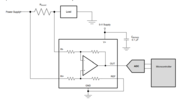I have this design for current measurements around uA to mA range.. maybe in the future few amps. Nice IC-chip amplifier for this purpose (INA21x). I have a relay to switch between different shunts to little bit change the range.
The problem is calibration. Could there be a design that I could switch on a relay to a precision current source. And what kind of current source would you recommend.. is there an IC for that, or what would be a good way to calibrate this thing? I have a DAQ with analog and digital IO, so using that I hope the system could be self-calibrating.
The problem is calibration. Could there be a design that I could switch on a relay to a precision current source. And what kind of current source would you recommend.. is there an IC for that, or what would be a good way to calibrate this thing? I have a DAQ with analog and digital IO, so using that I hope the system could be self-calibrating.


